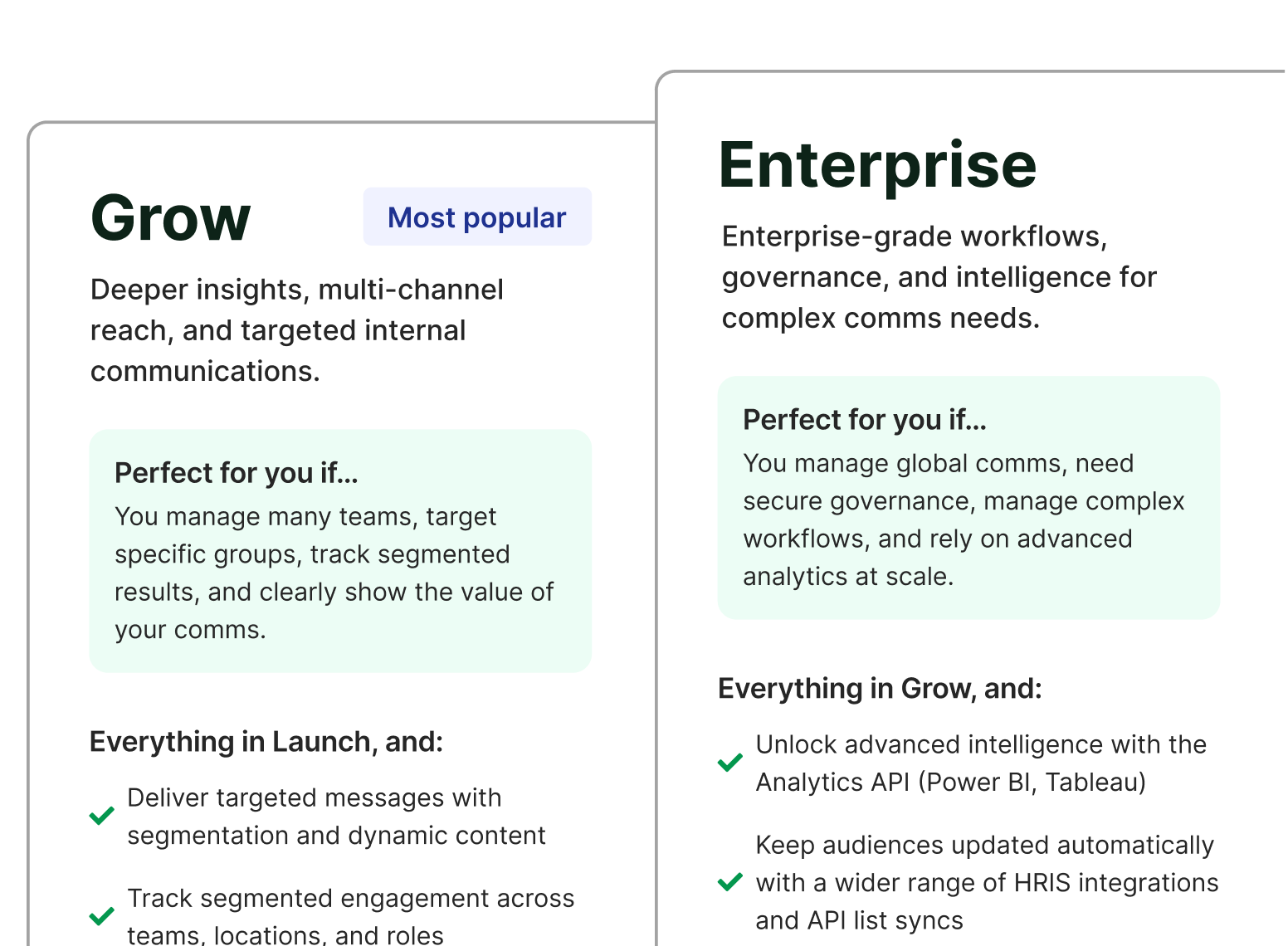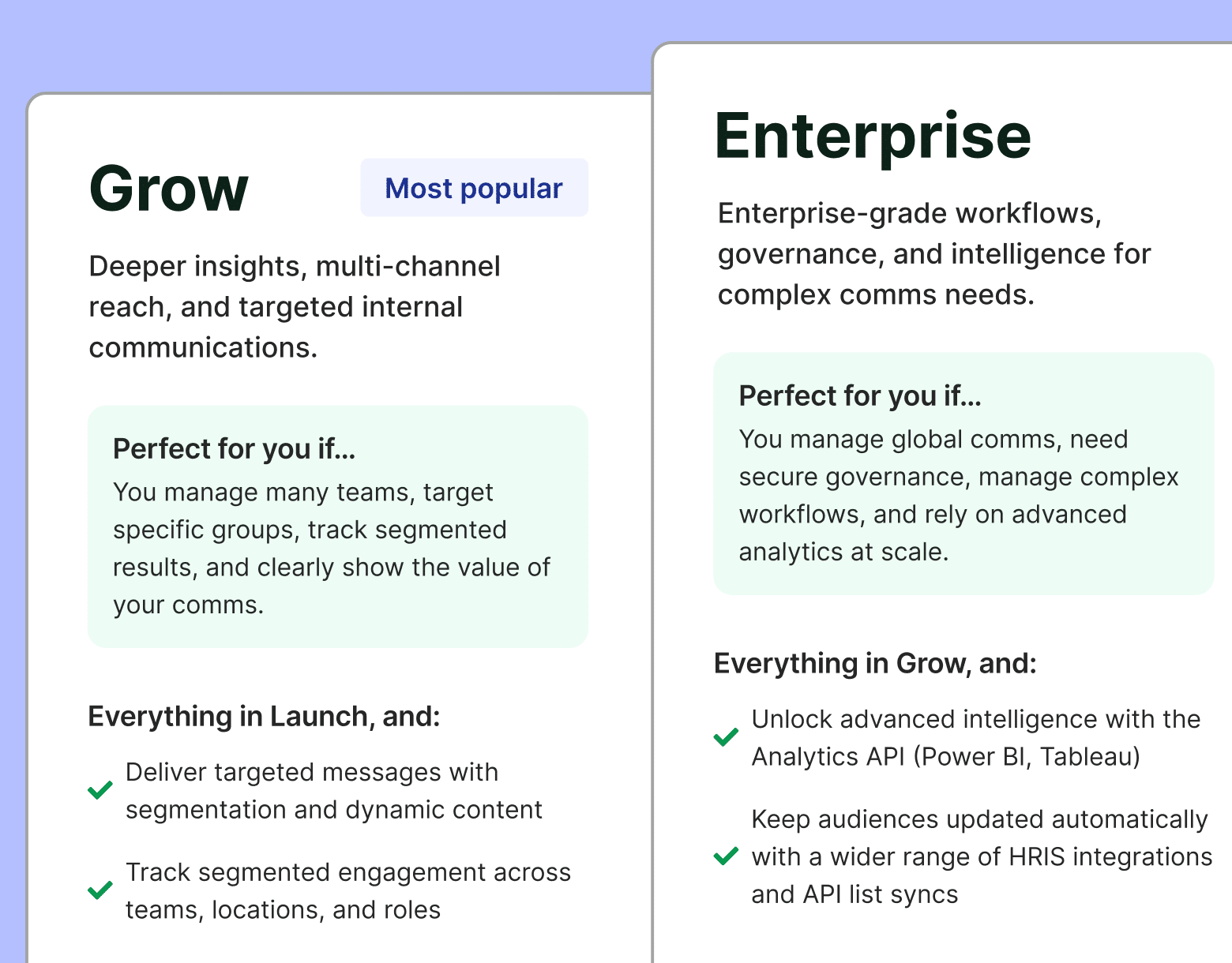Determining who is responsible for internal communications isn’t as straightforward as it seems. Unlike other departments or roles within a company, the ownership of internal communications is often shared among various individuals and teams.
When there’s no internal communications owner at a company, it’s hard for any real strategy to take flight. Without a dedicated internal communications team or individual, employee communications lack cohesion, overarching purpose, and engagement.
So, if you ask yourself, “Who is responsible for internal communications?” and if the answer isn’t clear, then you have a problem. Understanding who is in charge of internal communications is critical for success.
In this article, we’ll explore:
- What is internal communication?
- What are the common responsibilities of internal comms?
- Who owns internal communication?
- And much more.
Take a self-guided tour of ContactMonkey
See how our key features can streamline your internal communications.
Take product tour

What Is Internal Communication?
Internal communication (IC) is a crucial function that ensures smooth and effective information flows. The scope of IC can vary widely, from sharing management messages and launching campaigns to fostering two-way conversations and boosting employee morale.
What Are the Common Responsibilities of Internal Comms?
Internal communicators are responsible for creating, implementing, and managing internal communication strategies that align with the organization’s goals and objectives. These individuals are also responsible for owning that strategy in messaging across all internal communication channels.
Other common responsibilities of internal communicators include:
- Keeping everyone in the loop through staff intranet, email updates, social media, and newsletters. Check out this list of email newsletter best practices to dive into to create more engaging digital comms.
- Helping with executive and leadership communications by crafting messages, organizing agendas, and sorting out logistics for all-hands meetings and events.
- Building and rolling out strategic plans and goals to ensure everyone is aligned with the organization’s vision and values.
- Creating engaging content for internal platforms, like writing articles, making videos, and designing eye-catching content layouts.
- Checking how well communication efforts are performing and iterating on content cadence and themes based on team feedback.
- Offering guidance to leaders on the best ways to keep communication clear and consistent messaging across the board.
- Working closely with HR, IT, and other departments to bring in new technology, like internal email software, to streamline operations.
- Stepping up under special circumstances to lead the way in communicating internally through a crisis communication plan, during inclement weather or other unexpected events.
- Cultivating a workplace where everyone feels connected, collaborative, and positive through thoughtful and timely internal communications.
With the wide range of responsibilities that internal communicators have, it’s clear that this role requires a versatile and adaptable individual (or team) who can manage various channels and collaborate closely with different departments, like HR.
Modern internal comms and measurement tools
No design or technical expertise needed. Save time, increase engagement, and dazzle your employees with fun and interactive communications.
Explore all features

So, Who Is in Charge of Internal Communication?
Determining who is responsible for internal communications isn’t always straightforward. Depending on the organization’s size, values, and industry, IC could be handled by one person, an entire internal communications team, or just baked into HR. Many small or medium-sized organizations distribute the responsibility among a few individuals and teams.
Here are some of the common players involved in internal communications and their respective roles:
The people’s people: Human resources (HR)
HR departments are pivotal in steering internal communications, which is crucial in enhancing employee engagement and shaping company culture. They distribute vital HR-related information, including updates on benefits and policies, across various communication platforms.
HR departments are often regarded as the group who is in charge of internal communication. Throughout the employee lifecycle, from recruitment to offboarding, HR remains actively engaged, offering deep insights into the employee’s needs and feedback. This “middleman” role makes HR a strong natural partner for internal communications. In other words, HR and internal comms are inherently linked.
Utilizing data on employee engagement, retention, and satisfaction, HR can craft informed strategies for internal communications, ensuring a cohesive and engaging workplace.
Looking for HR-inspired internal communication samples? Check out our sample HR emails to employees.
Case for HR owning internal communications:
- HR has a deep understanding of employee needs and can tailor internal communication strategies accordingly.
- They are responsible for shaping company culture, making them natural candidates to lead internal communications efforts.
Case against HR owning internal communications:
- HR may lack the necessary skills and expertise to manage all aspects of internal communications effectively.
- They may face challenges prioritizing internal communication strategy alongside other HR-related responsibilities, leaning more towards ad hoc emails.
The macro view: Management/Leadership
Managers and leaders play a crucial role in the success (and scale) of internal communications within an organization. They must ensure that all vital information, goals, and expectations are communicated effectively to employees. Additionally, they need to actively listen and collect feedback from their teams and address any concerns.
At the same time, senior leadership leans on internal communications for the formulation and distribution of key messages, agendas, and information pertinent to company-wide meetings and events. Several scenarios make sense here, many of which are covered in our sample messages from CEOs to employees.
Unlock Internal Comms Superpowers
Discover why 10,000+ rely on us. See the internal email and employee newsletter platform in action.
Book demo

Internal communications teams are tasked with advising and supporting executives on optimal communication strategies with employees. Furthermore, there is a growing trend among organizations to appoint Chief Experience Officers or similar roles as owners of internal communications—to enhance and unify internal communications strategies.
Case for management/leadership owning internal communications:
- Managers and leaders have a direct line of communication with their teams, making it easier to disseminate information.
- They are responsible for setting the tone and direction of the company, so they should influence and participate in internal communications efforts.
Case against management/leadership owning internal communications:
- Managers and leaders may lack the time and resources to manage all aspects of internal communications effectively.
- They may struggle with finding a balance between top-down communication and promoting open dialogue within their teams. Additionally, they may not be as effective in getting authentic and honest employee feedback.
The natural choice: Marketing/Communications
Given their expertise in crafting effective messaging and managing various communication channels, marketing and communications teams are natural fits to lead IC. These teams are well-equipped to create visually appealing and engaging content. They tend to be already responsible for maintaining brand consistency, internally and externally, and understand internal communication strategy.
Moreover, marketing/communications departments often work closely with HR and other departments to disseminate information related to company updates, events, or initiatives. Their collaboration with other teams allows for a more holistic approach towards internal communications. Additionally, they have access to data and analytics that can help measure the effectiveness of internal communications efforts.
Case for marketing/communications owning internal communications:
- They have the necessary skills and experience in crafting messaging and managing communication channels effectively.
- Their collaboration with other departments allows for a more comprehensive approach to internal communications.
Case against marketing/communications owning internal communications:
- They may prioritize external communications over internal, impacting the effectiveness of internal messaging.
- They may lack a deep understanding of employee needs and challenges, leading to a disconnect in communication efforts.


The dedicated devotee: Internal communications team
Not all organizations boast a dedicated internal communications team (or individual), but nothing beats end-to-end ownership.
An internal communications team works intimately with other departments, guaranteeing consistent and effective messaging. Moreover, they play a pivotal role in assessing the success of diverse communication channels, ensuring that the organization’s message resonates clearly with its intended internal audience.
Many organizations have a specialized department or function focused on internal communications. This group is responsible for designing, developing, and disseminating internal content through various channels. Their oversight extends to building the processes and adopting the right technology, to building out an overall strategy to support business goals.
A dedicated internal communications team is responsible for monitoring and evaluating the impact of communication efforts on employee engagement, satisfaction, and retention.
Case for an internal communications team owning internal communications:
- They have the necessary expertise and resources to manage all aspects of internal communications.
- They can work closely with other departments to ensure consistent and effective organizational messaging.
Case against an internal communications team owning internal communications:
- Creating a specialized team may lead to siloed efforts and a lack of collaboration with other departments.
- Allocating resources to an internal communications team may be challenging for smaller organizations.
Decentralized/Departmental communications
In certain organizations, the duty of internal communications often falls on individual departments or their members. This decentralized approach to communication can be advantageous, particularly when there’s a necessity for messages that are specific to a department and not intended for the entire organization.
Despite the potential benefits, it’s vital to maintain consistency and ensure that all communications align with the overarching company messaging and objectives.
Adopting a decentralized model, some companies have started assigning a dedicated communications representative to each department. This strategy enables communications that are more personalized, relevant, and authentic—meeting the unique needs of different teams.
However, to achieve this, a central internal communications team must establish guidelines and uphold employer branding across the company.
Case for decentralized/departmental communications owning internal communications:
- Communications can be personalized and tailored to meet the specific needs of individual departments.
- Departmental representatives may have a better understanding of their team’s communication preferences and challenges, leading to more effective messaging.
Case against decentralized/departmental communications owning internal communications:
- Lack of consistency and alignment with the company’s overall messaging and objectives.
- Communication efforts may become siloed and uncoordinated, leading to confusion among employees.
Internal communications: The hybrid approach
Some organizations have successfully adopted a hybrid approach to internal communications, utilizing elements from multiple models discussed above. This approach involves collaboration between various departments, including HR, marketing/communications, and a dedicated internal communications team, to establish and execute an effective internal communication strategy.
This hybrid model combines expertise and resources from various departments, ensuring a holistic approach to internal communications. It also enables a personalized touch through departmental representatives while maintaining consistency and alignment with the company’s messaging and objectives.
However, this approach requires strong coordination and communication between all parties to avoid duplication or conflicting messaging.
Case for a hybrid approach to internal communications:
- Utilizes the strengths and resources of multiple departments, resulting in a comprehensive and effective communication strategy.
- Allows for personalization and tailoring of messages while maintaining consistency with overarching company messaging.
Case against a hybrid approach to internal communications:
- Requires strong coordination and communication between different departments, which can be challenging to manage.
- May result in duplication or conflicting messaging if not appropriately managed.
A Modern Approach to IC Strategy
Regardless of who is responsible for internal communications, employees across your organization must be empowered with modern internal communication tools and strategies.
The most effective way to do this is through internal communication software. Companies must invest in internal communication tools that facilitate real-time, two-way communication among employees at all levels.
Here are winning ways to make internal communication more effective:
Build stellar employee newsletters
Email is still the primary mode of communication for most organizations. A user-friendly email builder tool gives internal communicators a way to easily share relevant and timely updates, company news, and information with all employees at once.
Send out engaging pulse surveys
Pulse surveys offer a swift and efficient method for collecting employee feedback on various topics. Using the right tool, internal communication teams can quickly set up and distribute pulse surveys, receive instant responses, and analyze the data to gauge employee sentiment.
ContactMonkey’s pulse surveys enable you to collect real-time feedback directly from your employees. They’re perfect for including in your newsletter to assess employee feelings, gather suggestions, or evaluate the impact of particular initiatives.
Create compelling email newsletter copy with generative AI
Writing engaging copy can be a challenge for many internal communicators. With generative AI tools, they can quickly create compelling content by simply inputting basic information and letting the tool generate a draft. This saves time and ensures consistency in messaging.
If you want to learn more about how to use ChatGPT for internal communications, we’ve put together a step-by-step guide.
Monitor employee engagement, crunch data, and iterate
Staying on top of employee engagement is key to gauging how well your internal communications are doing. A contemporary strategy for internal communication helps you leverage tools that monitor employee engagement and offer insights for enhancement.
Consider using internal email analytics to monitor crucial metrics such as open rates, click-through rates, and feedback. This will help you figure out what’s hitting the mark and what needs a bit more work.
The Buyer’s Guide to Internal Communications Software
We did the research, so you don’t have to.
Get the guide

If an article gets a lot of clicks, think about adding more content like that in your next newsletters. Notice a survey with few takers? It could mean the content didn’t really hit the mark with employees. For instance, if an email isn’t getting opened much, why not play around with the subject line to catch more eyes?
With ContactMonkey’s analytics at your fingertips, tracking the success of your newsletter campaigns becomes a breeze. You’ll gain invaluable insights to make your future newsletters even better. Whether it’s a company-wide email blast or targeted communication to specific email groups in Gmail, or distribution lists in Outlook, ContactMonkey offers detailed data that helps you refine and elevate your content.
Understand employee engagement with click maps
With ContactMonkey’s click maps, you get a crystal-clear view of where your employees are engaging with your newsletter. This insight helps you pinpoint the most captivating content and guides you on tweaking your layout for even better engagement.
Take Charge of Who Owns Internal Communications
Effective internal communications are crucial in fostering a positive workplace culture, promoting transparency, and engaging all team members. It’s vital for companies to clearly define who oversees these communications, whether they choose a centralized, decentralized, or a mix of both approaches. Then, use modern IC technology to boost how you communicate internally. The right tools help you and your team ensure everyone is on the same page.
If there’s one key takeaway from this article, it’s this: employee engagement should be at the core of any internal communications strategy, regardless of who owns it.


